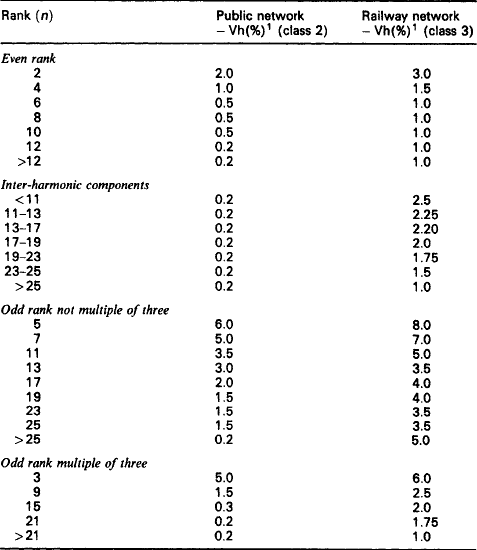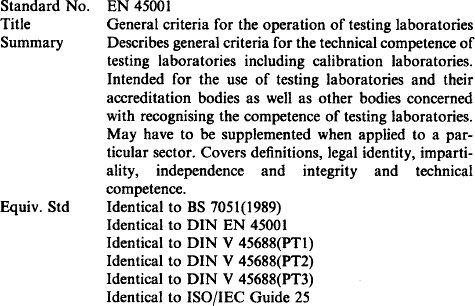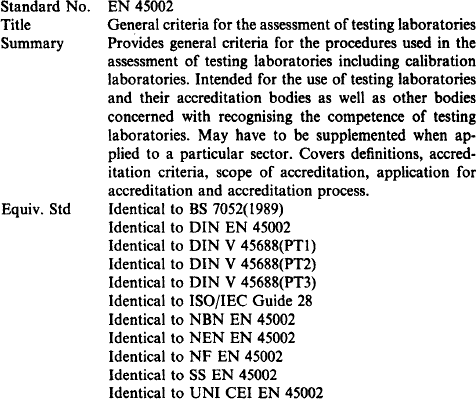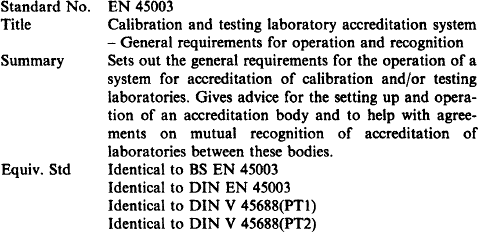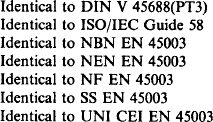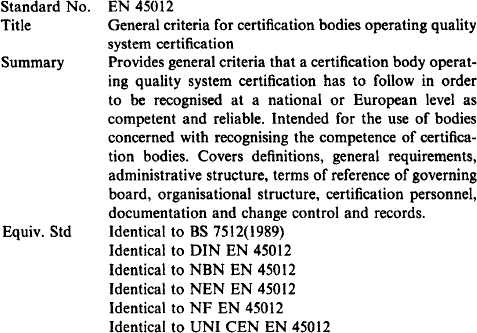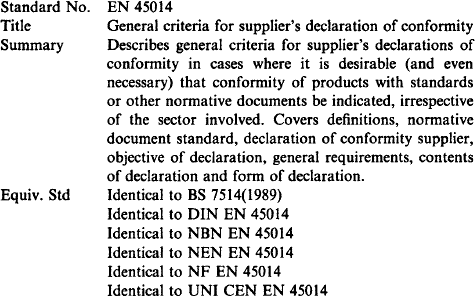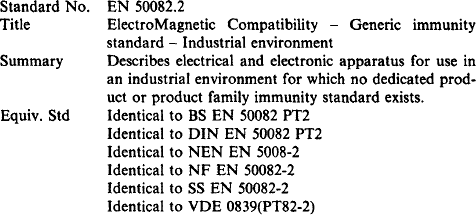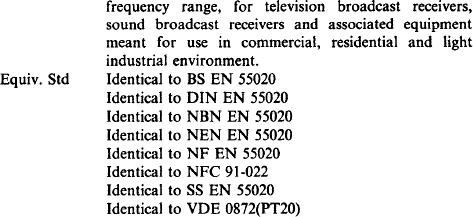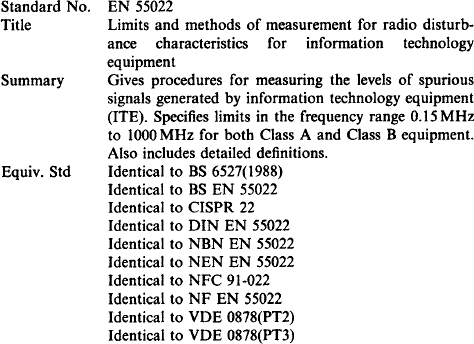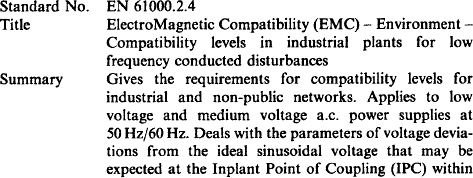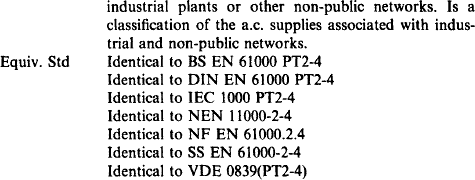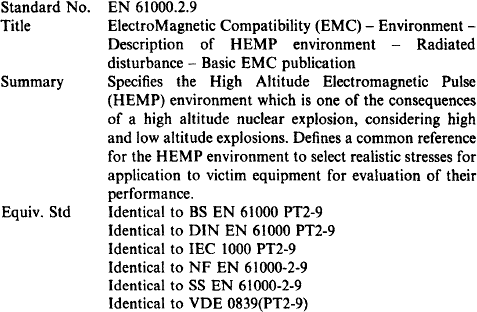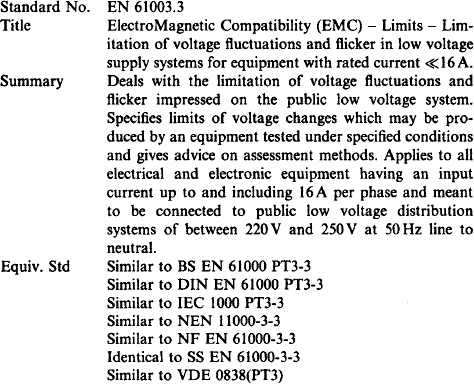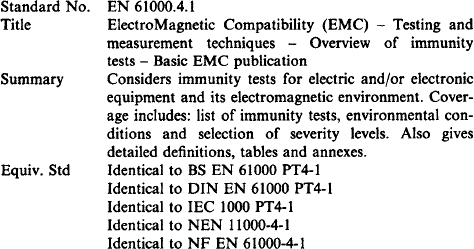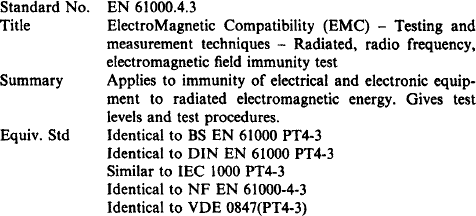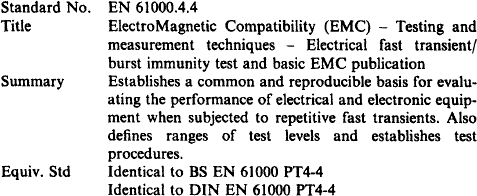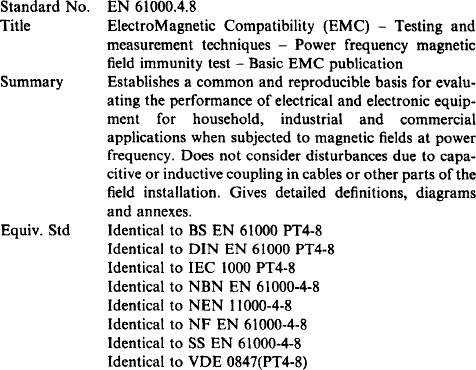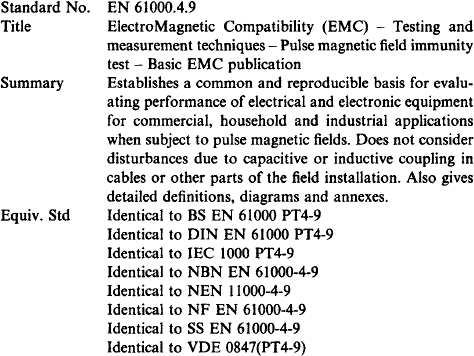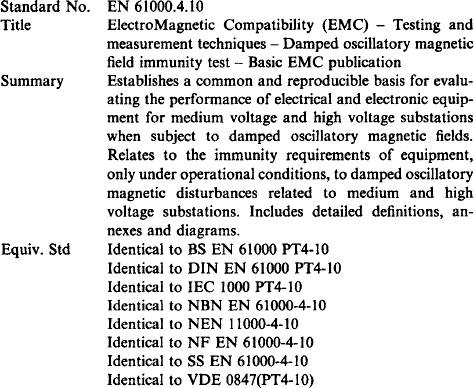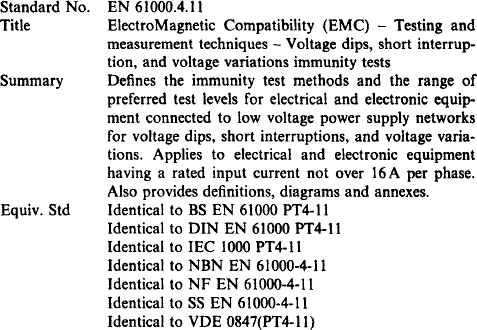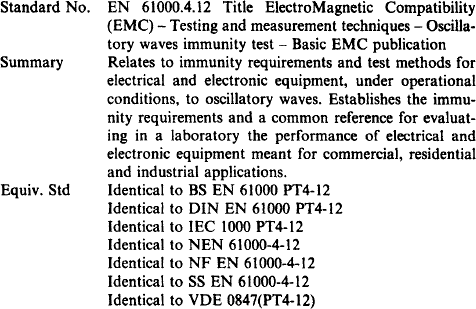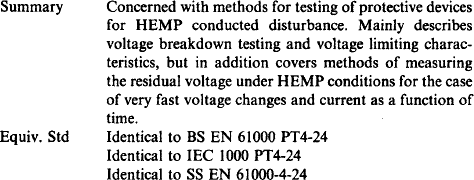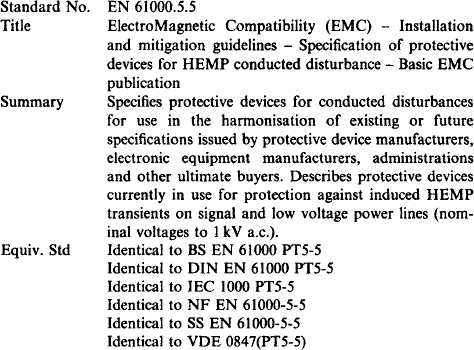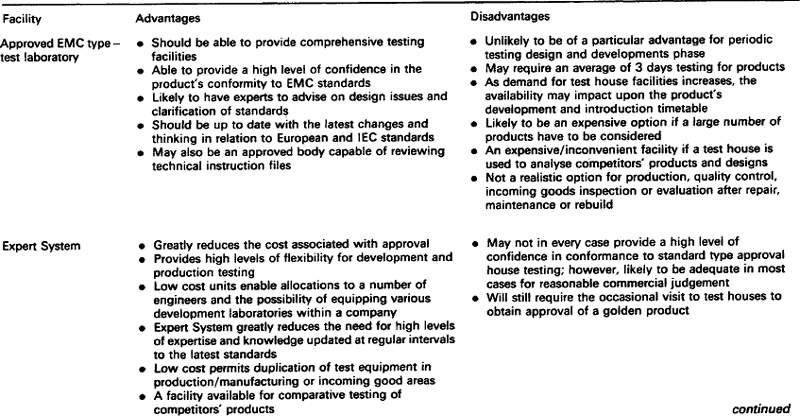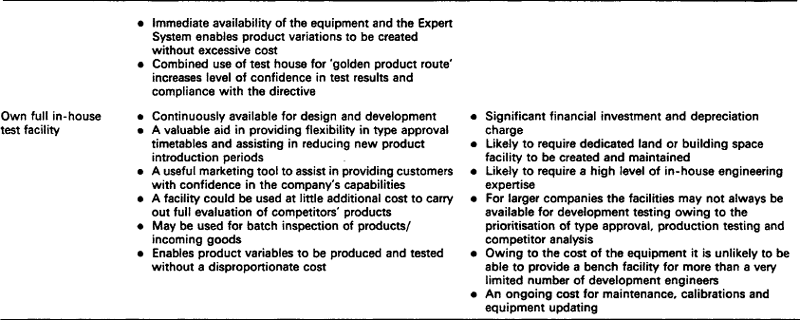Electromagnetic compatibility
10.1 Guidance
Most car owners normally accept that when they drive near electric pylons, their listening pleasure will be interrupted by loud crackles and/or buzzing noises. With the increased use of electronic equipment, however, the problem of interference has become one of our prime concerns. Although most forms of interference are usually tolerated as being one of those things ‘that you cannot do much about’, the design of modern sophisticated equipment has become so susceptible to electromagnetic interference that some form of regulation has had to be agreed.
Within Europe, this regulation is contained in Council Directive number 98/336 which clearly states that all electronic equipment shall be constructed so that:
10.2 The EMC Directive (89/336/EEC)
The main requirement of the EMC Directive (89/336/EEC, as amended by Directives 92/31/EEC and 93/68/EEC) is to ensure that throughout Europe the use of electronic equipment does not interfere with the operation of other equipment.
Under the terms of these publications, as of 1 January 1996, all active electronic devices have had to comply with the EMC Directive and only CE (Conformity Europe) marked equipment may be offered for sale. All active equipment connected to a network shall, therefore, be required to carry a CE mark and by virtue of this mark the user of such equipment has the suppliers’ guarantee of compliance with the EMC Directive.
10.2.1 EMC Directive – main clauses
To harmonise national provisions on electromagnetic disturbance levels by establishing protection requirements and referring the task of defining the characteristics of the products to European or national standards.
10.2.1.2 Application
The Directive applies to a wide sweep of equipment including in the widest sense all electrical apparatus, equipment and installations (including vehicles, electricity, transport and telecommunications distribution and transport networks) likely to cause, or be affected by, electromagnetic disturbance. The annex to the Directive includes a list of the equipment covered by the Directive as well as the equipment not covered.
10.2.1.4 Assessment procedures
The Directive provides for three assessment procedures for the conformity of apparatus:
• a procedure for apparatus for which the manufacturer has applied harmonised standards;
• a procedure for apparatus for which the manufacturer has not applied, or has applied only in part, the harmonised standards, or where standards do not exist;
• a procedure for apparatus designed for the transmission of radio communications.
10.2.1.5 Assessment bodies
The Directive refers to three bodies with different functions:
• ‘Competent authorities’, represented by the national administrations, which are responsible for the application of the relevant obligations;
• ‘Competent bodies’, which meet the criteria listed in the Directive and which are responsible for issuing the technical reports or certificates in accordance with the second procedure described in the assessment procedures;
• ‘Notified bodies’, which meet the criteria listed in the Directive and which are responsible for issuing the EC type examination certification in accordance with the third procedure described in the assessment procedures.
10.3 Enforcement of the EMC Directive
In the UK, enforcement of the EMC Directive is principally carried out by Local Authority Trading Standards Departments and the Department of Trade and Industry (DTI). Enforcement is primarily complaints driven rather than by market surveillance. The DTI has also adopted a softly-softly approach in the initial years that the EMC Directive is mandatory. It expects Trading Standards Officers to use a fair degree of discretion in dealing with non-compliant products, helping manufacturers to comply without resorting to formal enforcement measures, wherever possible.
Although other European countries have different arrangements for enforcement, the situation is unlikely to be very different from the UK.
The European Commission is reported as saying that enforcement is a key factor in the successful implementation of the New Approach Directives. It has a formal procedure to ensure that Directives are properly implemented and enforced in each Member State and, against some people’s expectations, the Commission is likely to take steps if it feels that Member States are not enforcing Directives!
A system has been set up, therefore, to allow administrative cooperation between officials in different countries. This will ensure, for example, the rapid circulation of information on non-compliant products or habitually offending companies.
Clearly, however, companies should not become complacent. The regulations exist and are now being implemented as European law and self-policing has proved to be one of the most cost effective ways of enforcing new laws.
10.4 Application of Council Directive 89/336/EEC
The guidelines for the ‘Application of Council Directive 89/336/EEC’ were first released in October 1993. In April 1996, government experts decided to rewrite them, a decision greatly influenced by industry and trade associations. The result was a document radically different from the original and considered by many as not being pragmatic.
In an effort to pacify Member States, a think-tank was set up to ‘rework the rewrite’, concentrating on areas in the text that caused concern due to translation problems. The revised document (which is officially only produced in English) is now available from the DTI but as the document is only intended to provide guidance when applying the Directive, it is bound to be seen as a means to an end for some manufacturers struggling with compliance.
However, whilst it should be remembered that the guidelines are only an interpretation of the Directive by a small group of representatives of the Member States, they do, nevertheless, represent an agreement between them on the most important points made in the Directive and are considered by the group to give a clear explanation on those points.
The definitions of components and systems also underwent a facelift and an area that was expected to be controversial was the addition of a clause that states a system made up of CE marked subassemblies can itself be CE marked automatically.
As Phillip Ling so poignantly pointed out in the 23 September 1997 issue of New Electronics, ‘CE = CE = CE?’; this caused concern with members of the EMC community and quite rightly so. The fact that a single subassembly operates within the specified limits laid down by the relevant standards is no guarantee that a system containing two or more units will still comply.
Yet a system falling outside of the scope of the Directive has been covered by the statement that such a system should be considered as ‘an optional combination of apparatus put together by an end user to perform a specific task’ and, as such, could be assumed justifiably to be compliant to:
10.5 Small businesses
Currently, the European Commission receives more angry mail about the EMC Directive than on any other subject. Most of these letters come from small businesses complaining about the additional burden being inflicted upon them.
However, whilst there is nothing in the Directive specifically aimed at the requirements of small businesses, being a New Approach Directive, it has been specifically designed so as not to handicap business or stifle innovation.
Thus while the Directive must contain a reference to harmonised standards, it does not need to state that any testing has been undertaken to these or to any other specifications. It is up to the signatory to consider whether the product would have passed if tested and to decide what risks are justified in the particular circumstances.
Enforcement of the EMC Directive works on the principle that action is taken by enforcers local to the manufacturer and non-compliant products are referred to the Trading Standards Officers who have a strict duty under EMC regulations to follow up these cases.
Already several cases have been investigated in the UK and the results have been expensive for 16 non-compliant companies. For instance, as a result of an official complaint from one of the company’s competitors, a Warwickshire firm manufacturing a household product had that item removed from the market after the Trading Standards Officer found that it contravened EMC regulations.
Worst of all, it took three months to redesign the product and retool the factory!
In another similar case, two PC assemblers were successfully prosecuted and fined in Wales for a non-compliant one-off product. Although in these cases there was no stock to seize, if a mass produced item fails, Trading Standards Officers would seize the entire stock.
10.6 Interference and other contract considerations
10.6.1 Exposure to interference
The amount of time an equipment is exposed to interference is a direct relationship to the actual electrical environment in which it is situated. In particular, it should be noted that interference can penetrate equipment on the electrical boundaries between the equipment and the electrical environment. Typically, these boundaries are:
10.6.2 Nature of the interference
A feature of the electrical/electronic environment is the wide range of amplitudes and frequencies that can cause electrical interference. The most important being:
But the problems that can occur as a result of electromagnetic environmentally supported disturbances (such as electrical storms) should also be considered.
10.6.2.1 Supply frequency interference
This interference originates from equipment power supply lines and from the traction supply in electrified areas. In a.c. electrified areas the dominant frequency is 50 Hz, which may be subject to significant harmonic distortion.
In d.c. electrified areas frequencies of 300 Hz and 1200 Hz may be present. Supply frequency interference is characterised by being of generally constant long-term amplitude at each site, but with extreme short-term variations under load changes, fault conditions, or supply changeovers.
10.6.2.2 High frequency burst interference
High frequency burst interference is caused by a sequence of sinusoidal bursts with frequencies up to several hundred kHz. Each burst decays over several tens of microseconds, with intervals of about 10 milliseconds (i.e. half a cycle of 50 Hz a.c.) between bursts.
10.6.2.3 Fast transient impulsive interference
Fast transient impulsive interference is caused by several frequencies in the MHz frequency region. Each burst decays over several hundred nanoseconds, with intervals of a few microseconds between bursts and with intervals of about 10 milliseconds (i.e. half a cycle of 50 Hz a.c.) between each sequence of bursts.
10.6.3 Electromagnetic environmental supported disturbances
10.6.3.1 Atmospheric discharges
Within Europe, electrical storms are comparatively rare as can be seen in the following table:
Table 10.1
| Storm frequency | 12–36 stormy days per year |
| Average duration of storm | 1.5 h |
| Number of discharges | 1–5.5 |
Although relatively infrequent, these storms can produce atmospheric discharges in the region of 40–100 kA/μs, together with a discharging current of 10–100 kA. These storms can have an effect on power supplies and communication lines and overvoltages may appear at connection points.
10.7 Typical contract requirements – EMC
All electronic equipment should be capable of withstanding transients (either directly induced or indirectly coupled) so that no damage or failure occurs during operation – assuming, that is, that the equipment will be used only for its intended purpose.
10.7.1.1 Power supplies
The following transients may be encountered on the power supply:
10.7.1.2 Permitted transient surges
The electronic equipment should withstand, without damage or abnormal operation, transient non-repetitive surges with an interval greater than 5000 times the duration of the surge. The transient surges should, with respect to the zero potential of the supply, be applied at the points of connection with external circuits, having Ü amplitudes in accordance with Table 10.3.
Table 10.3
| Amplitude Ü (kV) | D(*)(μs) |
| 7.0 | 0.1 |
| 4.0 | 1.0 |
| 3.0 | 5.0 |
| 1.5 | 50 |
| 0.8 | 100 |
(*)=time during which the overvoltage exceeds half the amplitude Ü.
10.7.2 Atmospheric disturbances
To counteract the effects of storms, it is generally recommended that all equipment should be capable of withstanding (as a minimum) the following overvoltages.
If the electronic equipment is not earthed, the voltage should be measured with respect to the vehicle frame.
10.7.3 Equipment Immunity levels
Most contracts will state that:
• ‘equipment should be immune to induced common-mode voltages with respect to earth up to and including 110 V r.m.s. per kilometre length of input/output line on any line or combination of lines’;
• ‘if an induced common-mode voltage (with respect to earth), greater than 110 V r.m.s. per kilometre length of In Out (I/O) line, but less than or equal to 440 V r.m.s. per kilometre length of I/O line, appears on any I/O line or combination of I/O lines, then the equipment will be permitted to adopt a temporary loss of availability’;
• ‘the equipment should not experience a permanent loss of availability or suffer component damage for any induced common-mode voltage within this range’.
10.7.3.2 Power supply lines
Contracts will normally state that equipment should be immune to high frequency bursts (see Table 10.5) generated as specified above and which will be coupled into the power supply lines (also see Test specifications).
Table 10.5
Test severity – power supply lines
| Initial peak to peak voltage | 1 kV |
| Burst repetition rate | 5 kHz |
The test procedure and the resulting evaluation for each item of equipment should be as specified for that particular equipment in the contract.
10.7.4 Power consumption
The supplier of the electronic equipment is normally required by the purchaser to specify its power consumption in order to enable calculations for the battery cabling.
10.7.5 Magnetic field
As low frequency fields can influence cathode ray tubes most contracts will recommend that equipment should be capable of withstanding these intensities, as follows:
10.7.7 Input/output connections from apparatus cases
Input/output connections from apparatus cases should always be of non-screened, non-balanced signalling cable and are normally restricted in length.
10.7.8 Local data transmission links
All local data transmission links (up to 10 km) are normally required to use screened, twisted-pair cables.
10.7.9 Long distance, point to point, data transmission
All long distance, point to point, data transmission using normal telecommunications cable are usually required to use balanced quad pairs.
10.8 EMC related standards
The following are the main standards associated with EMC, details of which have been extracted (with permission) from Infonorme London Information’s (ILI) Standards Information Disk.
10.8.4 EN 45004
| Standard No. | EN 45004 |
| Title | General criteria for the operation of various types of bodies performing inspection |
| Summary | Specifies general criteria for the competence of impartial bodies performing inspection irrespective of the sector involved. Meant for the use of inspection bodies and their accreditation bodies as well as other bodies concerned with recognising the competence of inspection bodies. Does not cover testing laboratories, certification bodies or the supplier’s declaration of conformity. |
| Equiv. Std | Identical to BS EN 45004 |
| Identical to DIN EN 45004 | |
| Identical to NF EN 45004 | |
| Identical to UNI CEI EN 45004 |
10.8.32 IEC 801.1
ElectroMagnetic Compatibility for industrial-process measurement and control equipment – General introduction.: Applies to electromagnetic compatibility of industrial process measurement and control equipment. Deals with general considerations in the context of the complexity of electromagnetic compatibility and the problems with which manufacturers and users of industrial process measurement and control equipment may be confronted. Ensures that manufacturers and users of industrial process measurement and control equipment are aware of the problems involved in achieving and maintaining electromagnetic compatibility. In addition provides the background information necessary to understand the development of the different parts of the standard on electromagnetic compatibility in the field of industrial process measurement and control.
10.8.33 IEC 801.2
ElectroMagnetic Compatibility for industrial-process measurement and control equipment – Electrostatic discharge requirements.: Applies to the susceptibility of industrial process measurement and control instrumentation to electrostatic discharges generated by operators touching this instrumentation and to electrostatic discharges generated between objects in the proximity of this instrumentation and establishes severity levels and the required test procedures. Establishes a common reference for evaluating the performance of industrial process measurement and control instrumentation when subjected to electrostatic discharges. Includes electrostatic discharges which may occur between electrostatically charged objects brought together near to the vital instrumentation.
10.8.34 IEC 801.3
ElectroMagnetic Compatibility for industrial-process measurement and control equipment – Radiated electromagnetic field requirements.: Applies to the susceptibility of industrial process measurement and control instrumentation to radiated electromagnetic energy. Establishes severity levels and the required test procedures. Establishes a common reference for evaluating the performance of industrial process measurement and control instrumentation when subjected to electromagnetic fields such as those generated by portable radio transceivers or any other device that will generate continuous wave radiated electromagnetic energy.
10.8.35 IEC 801.4
ElectroMagnetic Compatibility for industrial process measurement and control equipment – Electrical fast transient/burst requirements.: Relates to immunity of industrial process measurement and control instrumentation to repetitive electrical fast transients. Additionally establishes severity levels and test procedures. Establishes a common and reproducible basis for evaluating the performance of electronic instrumentation when this is subjected to repetitive fast transients (bursts), on either supply, signal or control lines. The test is intended to demonstrate the EMI of the instrumentation when subjected to types of transient interference such as that originating from switching transients (interruption of inductive loads, relay contact bounce, etc.).
10.9 Railway specific requirements
In addition to the generic requirements contained in 89/336/EEC, railway product specific requirements are detailed in ENV 50121 (Railway applications – ElectroMagnetic Compatibility), which consists of five sections, as follows:
| ENV 50121.1 | Railway applications – ElectroMagnetic Compatibility – General.(General description of the electromagnetic behaviour of a railway.) |
| ENV 50121.2 | Railway applications – ElectroMagnetic Compatibility – Emission of the whole railway system to the outside world. (Sets the emission limits from the railway to the outside world at radio frequencies.) |
| ENV 50121.3 | Railway applications – ElectroMagnetic Compatibility – Rolling stock – Trains and complete vehicles. (Specifies the emission and immunity requirements for all types of rolling stock.) |
| ENV 50121.4 | Railway applications – ElectroMagnetic Compatibility – Emission and immunity of the signalling and telecommunications apparatus. (Emission and immunity aspects of EMC for electrical and electronic apparatus intended for use on railway rolling stock.) |
| ENV 50121.5 | Railway applications – ElectroMagnetic Compatibility – Fixed power supply installations. (Applies to emission and immunity aspects of EMC for electrical and electronic apparatus and components for use in railway fixed installations associated with power supply.) |
1. These limits for electromagnetic compatibility are set so that the railway as a whole satisfies EC Directive 89/336/EEC regarding electromagnetic compatibility and so that electromagnetic compatibility is achieved between the various parts of the railway.
2. The standard specifies the limits for electromagnetic emission of the railway as a whole to the outside world together with immunity for equipment operating within the railways.
3. The frequency (covered by ENV 50121) is in the range of d.c. to 400 GHz.
10.10 Other related standards and specifications
| EN 50083.2 | Cabled distribution systems for television and sound signals – Electromagnetic compatibility for equipment |
| EN 50090.2.2 | Home and building electronic systems (HBES) – System overview – General technical requirements |
| EN 50091.2 | Uninterruptible power systems (UPS) – General safety and requirements for UPS used in operator access areas |
| EN 50130.4 | Alarm systems – Electromagnetic compatibility – Product family standard – Immunity requirements for components of fire, intruder and social alarm |
| EN 50199 | Electromagnetic compatibility – Product standard for arc welding |
| EN 55103.1 | Electromagnetic compatibility – Product family standard for audio, video, audio-visual and entertainment lighting control apparatus for professional use – Emission |
| EN 55103.2 | Electromagnetic compatibility – Product family standard for audio, video, audio-visual and entertainment lighting control apparatus for professional use – Immunity |
| EN 55104 | Electromagnetic compatibility – Immunity requirements for household appliances, tools and similar apparatus – Product family standard |
| EN 60439.1 | Low voltage switchgear and controlgear assemblies – Requirements for type tested and partially tested assemblies |
| EN 60521 | Class 0.5, 1 and 2 alternating current watthour meters |
| EN 60601.1.2 | Medical electrical equipment – General requirements for safety – Collateral standard: Electromagnetic compatibility – Requirements and tests |
| EN 60730.1 | Specification for automatic electrical controls for household and similar use – General requirements |
| EN 60730.2.11 | Automatic electrical controls for household and similar use – Particular requirements for energy regulators |
| EN 60730.2.5 | Automatic electrical controls for household and similar use – Particular requirements for automatic electrical burner control systems |
| EN 60730.2.6 | Automatic electrical controls for household and similar use – Particular requirements for automatic electrical pressure sensing controls including mechanical requirements |
| EN 60730.2.7 | Automatic electrical controls for household and similar use – Particular requirements for timers and time switches |
| EN 60730.2.8 | Automatic electrical controls for household and similar use – particular requirements for electrically operated wire valves, including mechanical requirements |
| EN 60730.2.9 | Automatic electrical controls for household and similar use – Particular requirements for temperature sensing controls |
| EN 60870.2.1 | Telecontrol equipment and systems – Operating conditions – Power supply and electromagnetic compatibility |
| EN 60945 | Maritime navigation and radio communication equipment and systems – General requirements – Methods of testing and required test results |
| EN 60947.1 | Low voltage switchgear and controlgear – General rules |
| EN 60947.2 | Low voltage switchgear and controlgear – Circuit breakers |
| EN 60947.3 | Low voltage switchgear and controlgear – Switches, disconnectors, switch-disconnectors and fuse-combination units |
| EN 60947.4.1 | Low voltage switchgear and controlgear – Contractors and motor-starters – Electromechanical contractors and motor-starters |
| EN 60947.5.1 | Low voltage switchgear and controlgear – Control circuit devices and switching elements – Electromechanical control circuit devices |
| EN 60947.5.2 | Low voltage switchgear and controlgear – Control circuit devices and switching elements |
| EN 60947.6.1 | Low voltage switchgear and controlgear – Multiple function equipment – Automatic transfer switching equipment |
| EN 60947.6.2 | Low voltage switchgear and controlgear – Multiple function equipment – Control and protective switching devices (or equipment) (CPS) |
| EN 61008.1 | Residual current operated circuit breakers without integral overcurrent protection for household and similar uses (RCCBs) – General rules |
| EN 61009.1 | Residual current operated circuit breakers with integral overcurrent protection for household and similar uses (RCBOs) – General rules |
| EN 61131.2 | Programmable controllers – Equipment requirements and test |
| EN 61543 | Residual current operated protective devices (RCDs) for household and similar use – Electromagnetic compatibility |
| EN 61547 | Equipment for general lighting purposes – Electromagnetic compatibility immunity requirements |
| EN 61800.3 | Adjustable speed electrical power drive systems – Electromagnetic compatibility product standard including specific test methods |
10.12 Test and evaluation
When equipment is being tested to ensure conformance with EMC requirements the following standards also need to be conformed with:
| EN 45001 | General criteria for the operation of testing laboratories |
| EN 45002 | General criteria for the assessment of testing laboratories |
| EN 45003 | Calibration and testing laboratory accreditation system – General requirements for operation and recognition |
| EN 45004 | General criteria for the operation of various types of bodies performing inspection |
| EN 45011 | General criteria for certification bodies operating product certification |
| EN 45012 | General criteria for certification bodies operating quality system certification |
| EN 45013 | General criteria for certification bodies operating certification of personnel |
| EN 45014 | General criteria for suppliers’ declaration of conformity |



